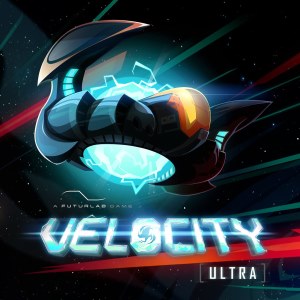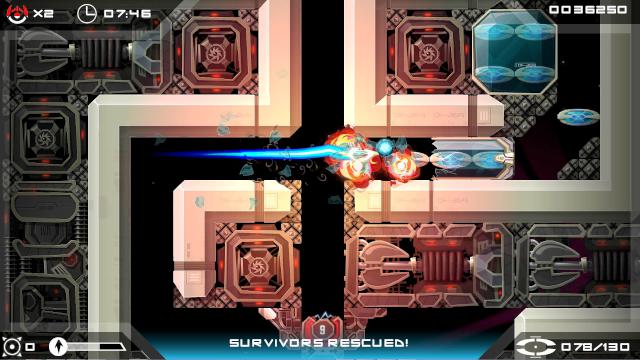
Watching a video of Velocity Ultra being played makes it look like a dauntingly difficult game. Scrolling screens are stressful for a neurotic like myself, and teleportation under time pressure just looked impossible. I hate R-Type, I suck at R-Type, so I always thought scrolling shooters just weren’t my thing. Then along came Velocity Ultra.
So I trepidatiously took control of the Quarp jet, a prototype single-seat warp-capable space-ship that can miraculously rescue hundreds of trapped colonists simply by flying into their icy prisons, and set off on my long journey up the screen. My objective? Pick up everything, and shoot everything else, as fast as I can. Of course. The narrative framing of Velocity has its charm but it’s by no means its biggest strength.
The most remarkable thing about Velocity is its control features. It’s a package of the simplest, varied, flexible and elegant mechanics that compliment and expand its genre far beyond any retro homage, and opens a whole new set of possibilities that I’m sure every developer wishes he thought of. The screen scrolls mercifully slowly, but you can, with a squeeze of the trigger, boost through a level, which is sometimes necessary in time critical scenarios. It’s freeing and exhilarating to have that choice. Your Quarp Jet will teleport anywhere on screen by holding square and just flicking the cursor over, it’s so quick and responsive that performing all those cool manoeuvres you saw in the trailer quickly becomes natural. It’s also really easy to kick ass with the enemies, as a flick of the right stick in the desired direction throws powerful projectiles. This game mapped its controller out to perfection, and to quote Todd Batty (maker of the brilliant SSX, yeah the new one, it was brilliant, shut up) ‘made awesome easy.’

Over fifty levels it may seem like all this scrolling and shooting could get a little repetitive, but there is easily enough variation to sustain it. In fact Velocity is as cerebral as it is energetic. Some levels are enemy-heavy blast-throughs where the objective is to kill ’em all and quick, others are time critical so any manoeuvring you do has to be fast and accurate. Others are complex mazes of laser barriers in which switches that have to be destroyed in order to open new areas, so creative and risky teleportation has to be done to complete them with a good time. Telepods are the final mercy of the game. They allow you to teleport back to any point you laid them and take the routes you couldn’t before. It’s what opens the scroller up to be a maze puzzle, but a super-cool-shooty maze puzzle, with flying enemies like Galaga, and spatial problem solving like Portal; and the comparison stands because it’s no less compelling in two dimensions. The exhilarating urgency with which you make decisions, and the ease with which you can execute them is enthralling and a mark of meticulously good game design. In fact every design decision made in this game appears to be the right one.
It is easier than it looks, but that doesn’t mean it isn’t a satisfying challenge, and if you’re the type of gamer that really enjoys punishment you’re going to love the bonus levels, because they are brutal, and potentially double the game’s duration. And if that isn’t enough they even put a level of Minesweeper in the menu, and for some reason a calculator. Love for gaming just seeps out of the presentation of this game, even the credits are a never-ending game of space invaders – which if you don’t play through you’re dead inside.
Velocity Ultra does for the scrolling shooter what Mario has been doing for platformers for 25 years. Perfecting, expanding and raising the quality of its genre. It stands with games like Fez, Braid and Pixeljunk Shooter as leading examples of post-retro game development. They need not stand on the shoulders of giants any longer, they grew wings. And a bitchin’ warp engine.
Reviewed on PS3


Leave a Reply